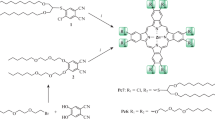Abstract
Although being an efficient photochromic compound which absorbs in the blue in its stable form and in the orange in its photoactivated form, the mercury dithizonate complex is shown to be a poor optical limiter for nanosecond laser pulses at the wavelengths where both isomers absorb. Optical limiting effect, which is a consequence of reverse saturable absorption due to the photoactivated form, is demonstrated to be weak because of the back photobleaching of this form, which is important all the more as the laser intensity is high. Numerical integration of the spatio-temporal evolution of the laser beam intensity across the solution helps the understanding of the respective roles of the laser fluence and pulse duration. Finally, we draw the conclusion that photochromic compounds can only be used as optical limiters if the time constant for the back photochemical reaction is slow compared to the pulse duration.
Similar content being viewed by others
References
For a general review on Photochromism, see Organic Photochromic and Thermochromic Compounds, vol. 1 and 2, ed. J. C. Crano and R. J. Guglielmetti, Plenum Press, New York, 1999.
C. B. McArdle, in Applied Photochromic Polymer Systems, ed. C.B. McArdle, Blackie, Glasgow, 1992, p. 1.
S. Maeda, in ref., p. 85.
N. Y. C. Chu, in Photochromism, Molecules and Systems, ed. H. Dürr and H. Bouas-Laurent, Elsevier, Amsterdam, 1990, p. 493.
B. Van Gemert, in ref.1, p. 111.
R. C. Bertelson, in Techniques of Chemistry, Vol. III: Photochromism, ed. G. H. Brown, Wiley-Interscience, New York, 1971, p. 45.
S. Schneider, A. Mindl, G. Elfinger and M Melzig, Photochromism of spirooxazines. I. Investigation of the primary processes in the ring opening reaction by picosecond time-resolved absorption and emission spectroscopy, Ber. Bunzenges Phys. Chem., 1987, 91, 1222–1224.
S. Aramaki, G. H. Atkinson, Spirooxazine photochromism: picosecond time resolved Raman and absorption spectroscopy, Chem. Phys. Lett., 1990, 170, 181–186.
Jean Aubard, in ref.1, p. 357.
J. W. Perry, in Nonlinear Optics of Organic Molecules and Polymers, ed. H. S. Nalwa and S. Miyata, CRC Press, Boca Raton, 1997, p. 813.
J. W. Perry, K. Mansour, S. R. Marder, K. J. Perry, D. Alvarez and I Choong, Enhanced reverse saturable absorption and optical limiting in heavy-atom-substituted phtalocyanines, Opt. Lett., 1994, 19, 625–628.
L. S. Meriwether, E. C. Breitner and C. L. Sloan, The photochromism of metal dithizonates, J. Am. Chem. Soc., 1965, 87, 4441–4448.
L. S. Meriwether, E. C. Breitner and N. B. Colthup,Kinetic, Infrared Study of photochromism of metal dithizonates, J. Am. Chem. Soc., 1965, 87, 4448–4454.
J. L. A. Webb, I. S. Bhatia, A. H. Corwin and A. G. Sharp, Reactions with heavy metals and their bearing on poisoning and antidote action, J. Am. Chem. Soc., 1950, 72, 91–95.
L. François, M. Mostafavi, J. Belloni, J. F. Delouis, J. A. Delaire and P. Feneyrou, Optical limitation induced by gold clusters 1. Size effect, J. Phys. Chem. B, 2000, 104, 6133–6139.
I. Texier, J. A. Delaire and C. Giannotti, Reactivity of the charge transfer excited state of sodium decatungstate at the nanosecond time scale, Phys. Chem. Chem. Phys., 2000, 2, 1205–1212.
M. Sumitani and K. Yoshihara, Direct observation of the rate for cis → trans and trans → cis photoisomerization of stilbene with picosecond laser photolysis, Bull. Chem. Soc. Japan, 1982, 55, 85–89.
V. Dentan, P. Feneyrou, F. Soyer, M. Vergnolle and P. Le Barny, Ph Robin, Broadband optical limiting and CCD sensor protection from nanosecond-pulsed laser threat with reverse saturable absorbers, Mater. Res. Soc. Symp. Proc., 1997, 479, 261–267.
H. Irving, G. Andrew and E. J. Risdon, studies with Dithizone. Part I The determination of, traces of mercury, J. Chem. Soc., 1949, 541–547.
J. F. Reith and K. W. Gerritsma, Photometric determination of micro quantities of mercury as mercuric dithizonate, Rec. Trav. Chim. Pays-Bas, 1945, 64, 41–46.
C. Goesling, A. W. Adamson and A. R. Gutierrez, Photochemical and kinetic studies of some metal dithizonate complexes, Inorg. Chim. Acta, 1978, 29, 279–287.
A. T. Hutton and H. M. N. H. Irving, Photochromism in Organomercury(II) dithizonates, J. Chem. Soc., Dalton Trans., 1982, 2299–2301.
R. Mitzner, G. Gottlöber, M. Herlt and E. Selke, Zum Mechanismus der Photochromie des Quecksilberdithizonats, Z. Phys. Chem. Leipzig, 1981, 262, 65–75.
N. Sertova, I. Petkov and J. M. Nunzi, Photochromism of mercury(II) dithizonate in solution, J. Photochem. Photobiol. A, 2000, 134, 163–168.
B. Paci, J. M. Nunzi, N. Sertova and I. Petkov, Picosecond anisotropy of the transient absorption of the photochromic mercury dithizone complex in solution, J. Photochem. Photobiol. A, 2000, 137, 141–144.
S. R. Varma and H. A. Mottola, Photochromism of silver(I) and mercury(II) dithizonates, Anal. Chim. Acta, 1986, 181, 245–251.
S. Schneider, Investigation of the photochromic effect of spiro[indolino-naphtoxazine] derivatives by time resolved spectroscopy, Z. Phys. Chem., 1987, 154, 91–119.
H. Miyasaka, S. Arai, A. Tabata, T. Nobuto, N. Mataga and M. Irie, Picosecond laser photolysis studies on photochromic reactions of 1,2-bis-(2,4,5-trimethyl-3-thienyl)maleic anhydride in solutions, Chem. Phys. Lett., 1994, 230, 249–254.
Author information
Authors and Affiliations
Additional information
† This paper is dedicated to Professor Jean Kossanyi on the event of his 70th birthday.
Rights and permissions
About this article
Cite this article
Feneyrou, P., Soyer, F., Le Barny, P. et al. Photochromic compounds as optical limiters in the nanosecond time range: the example of mercury dithizonate complex. Photochem Photobiol Sci 2, 195–202 (2003). https://doi.org/10.1039/b210944c
Received:
Accepted:
Published:
Issue Date:
DOI: https://doi.org/10.1039/b210944c




